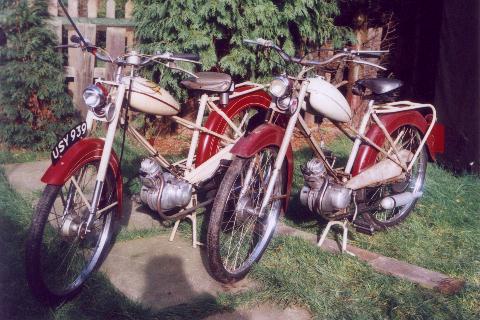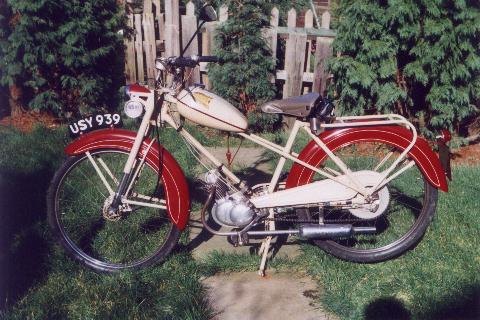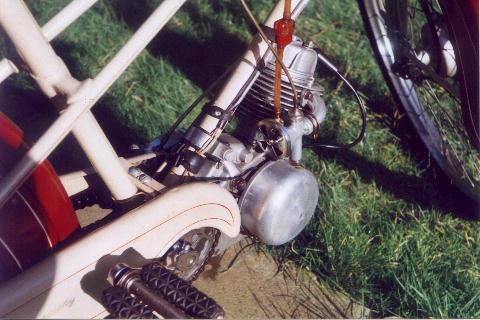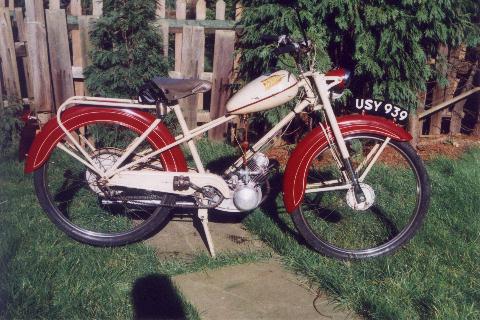 Go to the
Archive index
Go to the
Archive index
Hmmm, an all British 4-stroke moped? If any such machine ever existed, surely in 20 years Buzzing would have done an item on it before? At least the mainstream magazines or motor cycle book publishers would have dug it up and made a splash out of it. Everyone can’t have just missed it! It may sound like a myth, but such a machine really did appear at the Earls Court Motor Cycle show in 1955. Today, a mere four examples are known to survive in NACC captivity as a testament to the ambitions of a Birmingham cycle manufacturer, back from a Lost World—The Mercury Mercette still lives!
The 2bhp @ 5,200rpm ohv engine was obviously an original design, and a marked diversion from the expected 2-strokes that dominate the smaller capacities. An all alloy unit construction with two-gears and a dry clutch, the 39mm square bore and stroke calculates out at 46.6cc, but Mercury chose to call it a ‘48’. The round finning on the alloy barrel and cross-flow Heron head gave it an oddly quaint appearance with an Amal 360/12mm carb on the right, and sweeping curvy exhaust pipe to the left. A Wipac Series 90 was the chosen electrical set mounted directly on the crank, so produced a wasted spark on alternate revolutions, and featured no ignition advance/retard facility, though the motor incredibly seemed to start and run ok! Lubrication was described as ‘splash/oil mist’, meaning there was no pump, and basically relied upon the gears just chucking it all about. The motor’s internal mechanics were where the real mind-bending stuff went on, the cam lobes being integral on the gear input shaft between 1st and 2nd! This was driven from the crank pinion by a reduction idler gear, which all required lining up when cam timing; no problem there, but when you rotate the crank and the marks only line up again in 8 revolutions - you do wonder if you’re going a bit mad! It may all sound very technical, but actually reduced the components involved and made the engine quite straightforward to assemble, just as long as you didn’t try to think too hard about how that cam timing actually worked.

The Mercette rigid frame pattern is known as a Mixte (from the French for mixture, being suited for both gentlemen and ladies), which construction was renowned in the cycle world for its strength, and became the favoured form for the old style Cyclo-Cross events. A negative aspect of the design is that it tends to make the upper frame space physically wider, and can become a problem when pedalling, though obviously not much of a concern with a moped. Front forks were undamped telescopic, and the 26"×2"×1¾" wheels amply covered by heavy, side shielded mudguards. The reason the rear carrier was so substantially constructed was its dual function as a sub-frame for mounting an optional pillion seat with rear footrests, so Mercury were obviously very optimistic about their machine’s capability.
Other options included a Smiths speedometer kit mounting on the front wheel, and even a factory megaphone to replace the standard Burgess sausage silencer. Illumination, in no great excesses, came from 6V Miller cycle lamps around 6W/5W front and rear, while the token Miller horn was far less likely to frighten the chickens than the racket coming out the end of the exhaust pipe. Finish was a Mercury light grey (which generally seems to fade to beige over time), with maroon mudguards, then lashings of lining all over everything, which was part of the cheap and popular fashion to brighten-up the post-war years of austerity. Still, the Mercette was a large skinny clothes horse so it wore these trappings well, unlike some of its smaller wheeled contemporaries, which looked like tacky, over-decorated seaside souvenirs.

So much for the general overview, but confronting the beast face-to-face is a whole different thing - this really is one big framed moped, by no means heavy though, since its structure is very skeletal, with the little engine dangling beneath the front down-tube. Now the wise move with a mythical creature like this, is to study and understand the complications of the bizarre contraption you are obviously proposing to ride before naively taking off and killing yourself, and believe me, this is just the machine to do it! It’s a 2-speed hand twist-shift with a normal lever clutch, so you’d naturally expect to find a back-pedal brake … but it’s just a conventional cycle freewheel, so follow the rear brake cable back to its source and you end up at the right hand lever! So where’s the front brake? There’s a second lever on the left bar cluster with the clutch and gearshift, and now you know you really are in trouble! This bike was designed by an inversion freak with two hands on his left arm! For a mere mortal to ride one of these devices with any chance of surviving is going to take a very different technique. Right, the plan is, whenever you want to slow down, to switch into neutral first so you can control both brakes as much as required, then select whatever desired gear to continue again; probably not the fastest riding style, but we may at least get through this. Now, how do you start the damn thing? Fuel on - yes, strangler on the carb - have some of that, off/on/light switch - central position, push on the pedals—and only the back wheel goes round. Ok … let’s try it in 1st, push on the pedal - nothing moves, stand on the pedal - nothing moves against the compression. Ok … let’s try it in 2nd—cough, bang. Then again with a little throttle—cough! bang!—yes! What a din, you know it’s started alright! Now quickly into neutral, keep it going on the throttle, and stretch over the frame to turn off the strangler.
It’s best practice with splash oilers to give them a minute at low revs to get the oil round … then taking our life into our hands, it’s off we go! First gear goes in with a clunk, but you’ve got to expect that since the clutch is mounted off the outside end of the output shaft between the front sprocket and the gearbox, not between the engine and gearbox like conventional engineering practice. So, remembering that every shift is going to be a crash change, it’s a relief to find at least the dry clutch feeds in nicely, and turning on the throttle the Mercette surges up the road with a throaty growl. Crash into second with a big ratio jump and build up to a steady chuffing, cruising speed, then hope you’re not going to have to stop again too soon. Settling down on the move gives you chance to take stock of your precarious situation. Because of the tall frame you have a high centre of gravity, and with the long wheel-base, the ride becomes more stable with speed. The amount of clattering, whirring and general engine noise that comes up at the rider could easily be enough to cultivate total paranoia in the mechanically sympathetic, but all accompanying riders say it sounds just brilliant so I figure it’s best to go with their opinion. The oddest thing is thundering along at 25mph on this thing that sounds like a 250 BSA, which is certainly some cause for confusion and amusement to spectating pedestrians, who look round for a big classic bike, and see—a peculiar engined moped!
The undamped telescopic forks soak up the worst of the road bumps, but the rigid rear end proves quite a test of durability for the rider. Once you get used to the whole alien experience, the handling manners feel quite good on smooth roads and it’d take a brave (or crazy) rider to push it to cornering limits. Despite the 2bhp rating of the motor, it’s only got half the firepower of its 2-stroke cousins so tends to fade away on inclines in top gear. The lights don’t prove to be too bad considering their feeble wattage and are not far below the limited capability of the performance. Mercury stated a top speed of 37mph solo and 30mph two-up, there may be some optimism here, but 45 years down the line these claims are unlikely to be tested much on such an elderly and rare machine. Riding the Mercette is real biplane aviator stuff, and it surely ranks among the most fantastic rally machines for sheer rarity, general interest and that wonderful 4-stroke sound. Wind on the throttle and it bops away like a classic single, running at cruising speeds of 25 - 30mph and the motor’s snarling at the world as though it really means business, then roll down the throttle and there’s that familiar overrun growl. The Mercette is a moped that thinks it’s a big motor cycle! When chuffing along a smooth, clear road it’s a marvellous ride, but in practical terms—Kamikaze pilots only!

After the Earls Court Show in 1955, the Mercette became recorded in manufacturers’ lists from February 1956 but didn’t actually start arriving in showrooms till July, so most of the first sales season had been missed. This delay must be credited to engine supply. The motor’s only identification was the mark of "Mercury Industries" moulded into the dipstick cap, but its true origin would not become apparent to the motor cycling public until April 1957 when the Hounslow perambulator manufacturer Dunkley announced their Whippet 60. Dunkley built several kick-start variations on their little 4-stroke engine theme, but the pedal-start Mercette motor was uniquely made for Mercury, and few parts were compatible between the types. Dunkley and Mercury seemed to share many common parts on their machines, petrol tanks, front forks, and even paint. It was sometimes hard to tell where one company ended and the other began. Mercette frame serials ran from 100 to 765 by October 1957, at which time Mercury were getting into trouble. By the next month, the reduced workforce was on short time, and what resources the factory had in the ‘motorised division’ were probably being concentrated toward the new Pippin Scooter. The Palace of Cards collapsed on March 1st 1958 and all production at Mercury ceased on this date. With massive debts, Mercury Industries entered into voluntary liquidation on the 20th March. The brief flight by the winged messenger of Roman Gods was over. The buying public never did take to the Mercette, and who could blame them? It was a user-unfriendly monstrosity that developed an unpleasant mechanical reputation for dropping its valve seats out of the cylinder head! There is little evidence to suggest any more Mercettes were completed beyond the 665 October figure, and the four rare and invaluable survivors leave just a tiny window to glimpse back into the Lost World of Mercury. Dunkley continued briefly, introducing their 49cc Popular Scooter in August 1958, followed by the 65cc Popular Major Scooter in December, but by spring of the next year had been taken over by M.G.Holdings, who also swallowed up Dayton Cycles, and in May transferred all production to the Park Royal site. This was probably no more than an exercise of building out acquisition stock, since the Dunkley range was dropped at the end of 1959, followed by Dayton models also going out of production after the 1960 season.
Anyone with an example of the few surviving Mercury or Dunkley models today is going to have big problems regarding parts and information, but fortunately some salvation is at hand. Despite the reclusive obscurity of the brands, the Dunkley/Mercury registry and contact groups are by far the most active marques in the NACC. The quarterly newsletters now stretch over 20 pages and include machine registries, technical notes and library references on over 60 related items. The group is generating its own transfers, making spare parts and centralising machines and components. It’s simply the only way back from the brink of extinction for endangered species.
For the next item, recent investigations have uncovered the existence of a disturbing sub-culture having grown up within the ranks of the NACC. This seemingly revolves around a religious adulation of primitive suspension systems and the performing of pagan ceremonies involving worship with diabolical artefacts comprising of peculiar rubber cupped implements fixed to long wooden handles! The forthcoming article is set to expose some of these bizarre machines and their strange disciples. Find out what’s going on in the next shocking issue—you can’t afford to miss it!
This article was first published in April 2002. A revised and updated article on the Mercury Mercette was published in Iceni CAM Magazine in October 2025.